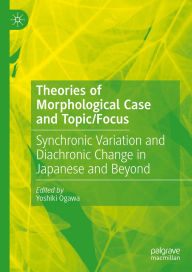Read [Pdf]> Theories of Morphological Case and
Theories of Morphological Case and Topic/Focus: Synchronic Variation and Diachronic Change in Japanese and Beyond by Yoshiki Ogawa


- Theories of Morphological Case and Topic/Focus: Synchronic Variation and Diachronic Change in Japanese and Beyond
- Yoshiki Ogawa
- Page: 415
- Format: pdf, ePub, mobi, fb2
- ISBN: 9783031683145
- Publisher: Springer Nature Switzerland
Books for free download in pdf Theories of Morphological Case and Topic/Focus: Synchronic Variation and Diachronic Change in Japanese and Beyond by Yoshiki Ogawa English version
This edited book brings together studies on morphological case in Japanese, English, and Bantu languages, among others, from morphosyntactic, semantic and historical perspectives. Languages are divided into two types in terms of case: nominative-accusative languages and ergative-absolutive languages. Even if we limit our attention to nominative-accusative languages, morphological case on subjects and objects can vary across languages or even within a single language, either synchronically or diachronically. For instance, certain stative predicates in Japanese allow their subjects and objects to be marked with dative and nominative case, respectively, and subjects in adnominal clauses in Japanese can be marked with genitive case; moreover, genitive subject marking in adnominal clauses has decreased over the past few centuries. Licensing relationships between predicates and cases can also have idiolectal, dialectal, and/or geographical micro-variations and intergenerational and/or diachronic micro-change. This book draws parallels and examines differences between examples of European, Asian and African languages, and discusses whether and how licensing of certain morphological cases (especially, subject marking) is related to the grammatical functions such as Topic and Focus. It will be of interest to researchers in Theoretical Linguistics, particularly those involved with Language Variation and Change, Linguistic Typology, Morphology and Syntax, and Generative Grammar.
Theories of Morphological Case and Topic/Focus : Synchronic .
This edited book brings together studies on morphological case in Japanese . Subject and Topic/Focus: Its Synchronic Variation and Diachronic Change.
Theories of Morphological Case and Topic/Focus: Synchronic .
This edited book brings together studies on morphological case in Japanese, English, and Bantu languages, among others, from morphosyntactic, semantic and .
The evolutionary dynamics of how languages signal who does what .
Three main strategies to indicate the participant roles of “who” and “whom” are case, verbal indexing, and rigid word order.
Theories of Morphological Case and Topic/Focus: Synchronic .
This edited book brings together studies on morphological case in Japanese, English, and Bantu languages, among others, from morphosyntactic, semantic and .
[PDF] THE ROLE OF PROCESSING COMPLEXITY IN WORD ORDER .
All normal humans have the same basic cognitive capacity for language. Nevertheless, the world's languages differ in the kind and number of grammatical .
[PDF] Diachronic Cognitive Linguistics - OSF
His proposal that a variety of synchronic and diachronic factors interact in giving rise to linguistic structure (Langacker 1987: 28) can now be considered .
0コメント